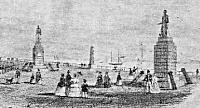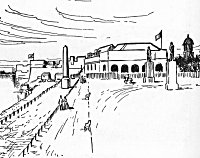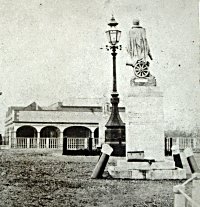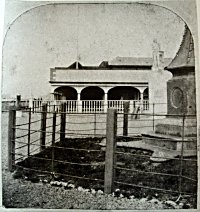Location
Adjacent to Clarence Pier.
Description
Two statues in Limestone, one of the Duke of Wellington and the other of Lord Nelson, both around seven feet high, standing on eight foot high pedestals. The statue of Nelson was last seen c1860 and that of Wellington around 1874.



May 18, 1850
The Two Statues

From "Portsmouth in the Past"
The Two Statues

Photo by kind permission of the City Museum
The Statue of Lord Nelson

Photo by kind permission of the City Museum
The Story
In 1850 Lieutenant-General Lord Frederick FitzClarence was coming to the end of his command of the Portsmouth Garrison. As was customary in these circumstances, he decided to make a gift to the people of Portsmouth. This may not have been altogether altruistic as he had hopes of becoming Liberal MP for Portsmouth and was perhaps garnering favour from the local populace.
His gift was to be two enormous statues of the nation's heroes, the Duke of Wellington and Admiral Lord Nelson, which were to be placed on Southsea Common. Unfortunately they seem to have raised great controversy from the outset. In particular, it was alleged that FitzClarence had arranged that the statues faced inland, across the common, where they could review the troops. This incensed the navy, who asked why Nelson should be required to review the "cavortings of the Junior Service" - and what sort of an admiral would keep watch by turning his back on the old enemy, France.
In May 1850 the statues were erected and the unveiling was set for Waterloo Day, June 18th. The event was widely publicised and brought people from as far away as the Midlands. At the appointed hour FitzClarence was nowhere to be found and it took some hours to locate him amongst the many drinking booths on the common. Unsuprisingly the delay allowed time for the crowd to consume a large amount of alcohol and when they heard there would be a display of drill marching rather than the re-enactment of the Battle of Waterloo as they had been promised, things got out of hand.
Order was eventually restored and the statues were duly unveiled.
They remained standing on the common for a number of years, quickly succumbing to erosion caused by the salt air, until one night they vanished. According to legend, a well known naval officer organised a party of Bluejackets who swarmed ashore at night and simply removed the statue of Nelson, possibly throwing it into the sea, but no one was ever charged with the offence.
Further Information
The matter of the exact siting of the statues was initially confusing, given that two successive Ordance Survey maps of the area placed them in somewhat different orientations. On the earlier map (1861) they are situated on a line parallel to the shoreline just east of what is now Clarence Pier. On the later (1867) they are in a line at right angles to the shoreline in direct line with the eastern side of Pier Road - the Wellington Statue at a point where the line crosses the north side of Clarence Esplanade and the Nelson Statue further south immediately outside what was then (in 2006) a Wimpy Bar.
A drawing of the period that appeared in "Portsmouth in the Past" by William Gates showed the statues in line, parallel to the shoreline outside the Hollingsworth (later Kings) Rooms.
On his local history website, Stephen Pomeroy placed the two statues either side of Pier Road. The 6in. OS map revised in 1873-4 records a single unnamed statue in what is now the car park at Clarence Pier. It is probable that this was the statue of Wellington which remained in place at least until 1874.
The true fate of the statues was partially resolved in 2008 when two photos (see left) taken around 1855 were discovered in Portsmouth City Museum. These showed the two statues in the same orientation and position as in the Gates drawing but contrary to legend, Nelson is not facing inland but towards Wellington, ie along the shoreline, pointing in a south-easterly direction which would if extended reach France. As the issue of the direction faced by Nelson has been proved, it suggests that the story of the bluejackets is incorrect as their hero would not have had to 'review the troops' and was not facing inland.
